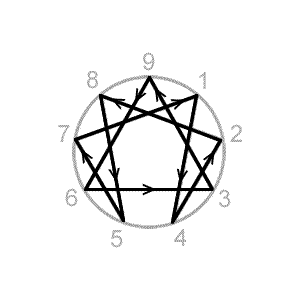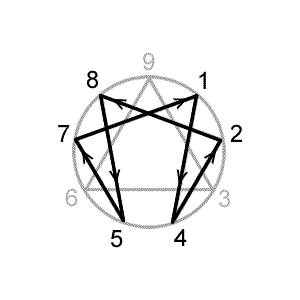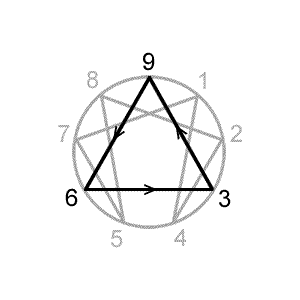The Enneagram Arrows and Lines: Movement between the types

The inner lines of the Enneagram symbol connect two other numbers to any given number.
The arrows are sometimes used to describe what kind of connection that is. One line has an arrow pointing away from the number and the other line has an arrow pointing toward the number.
Using both the lines and arrows
There are two schools of thought on applying the inner lines and arrows to the personality types that developed separately: stress / security points and directions of disintegration / integration. These two approaches are similar but have their differences as well.
With both these approaches the line pointing toward the type has one meaning while the line pointing away from the type has another meaning.
For example, type 1 has lines connecting to types 4 and 7. The line from 1 to 4 has the arrow pointing away from 1 and towards 4. With the line from 1 to 7 the arrow points toward 1 and away from 7.
While there is a connection from 1 to both 4 and 7, the arrows indicate each connection has a different meaning when viewed from type 1.
Type 4 is said to be the stress point of type 1 in one school, while it's said that type 4 is the direction of disintegration for type 1 in another school.
Type 7 on the other hand is said to be the security point of type 1 for one school and the direction of integration for another school.
You can read more about these two approaches on the Enneagram stress and growth page here.
Using just the lines without the arrows
When the arrows are not used, the lines are simply referred to as connecting points between the types. The arrows are ignored and the lines to both types represent the same thing.
For example, type 1 has connecting points at 4 and 7. Types 4 and 7 are said to have an influence on type 1 in that a person who's primary type is 1 may take on type 4 and type 7 characteristics at times.
Another way to say it is that type 1 may move to type 4 and type 7 temporarily.
The problem with the lines and arrows
The patterns of the lines and arrows are not the same for all nine types.
For types 1, 3, 6, 8, and 9 the lines are the same (i.e., they connect to points that are two points to the left and right). This is not the case for types 2, 4, 5, and 7.
To assign all the lines the same meaning ignores this difference.
Additionally, there is no underlying psychological reasoning to support the idea that moving with or against the arrows should have different meaning. These meanings exist simply to explain the arrows on the symbol.
The real issue is that the types are looking at the lines as a single pattern but they're really part of two separate patterns.
The Enneagram hexad

The lines connecting points 1, 2, 4, 5, 7, and 8 form a six-pointed figure referred to as the hexad. The reason the lines are connected the way they are has to do with what Gurdjieff called the law of 7.
Divide 7 by any number between 1 and 6 and you get decimal results with the same repeating sequence of numbers.
1/7 = .142857...
2/7 = .285714...
3/7 = .428571...
4/7 = .571428...
5/7 = .714285...
6/7 = .857142...
This sequence of numbers not only connects the lines to the numbers but places the arrows on the lines in the direction of the sequence.
The Enneagram triangle

The lines connecting points 3, 6, and 9 represent the law of 3 for Gurdjieff, mathematically represented by the following repeating decimals.
1/3 = .3333...
2/3 = .3333... + .3333... = .6666...
3/3 = .3333... + .3333... + .3333 = .9999...
Inconsistencies of the lines and arrows
The original use of the inner lines and arrows on the Enneagram symbol was quite different from the way the personality types use them today. Gurdjieff used the hexad for one purpose and the triangle for another.
When you take a symbol such as the Enneagram and use it for a different purpose, contradictions can occur.
Attempting to give a single meaning (the inner lines and arrows) to two different patterns (the hexad and triangle) raises the question of whether the meaning can be equally applied to all nine types and their connections.
The bottom line, like everything else for the Enneagram personality types, use the lines and arrows if they work for you, otherwise don't. Due to the inconsistencies of the lines and arbitrariness of the arrows you may find they work better for some types than others.
Click here for the Complete Guide to the Enneagram.
This free guide explains- the nine Enneagram personality types
- the many type variations within type
- where the types came from (origins and history)
- how the types use the Enneagram symbol
Click here for Enneagram tests.
These free tests help you find your- primary type
- candidate types
- preferred wing
- intinctual subtype
- instinctual variant stacking
- center types (gut, heart, and head)
- tri-center with wings